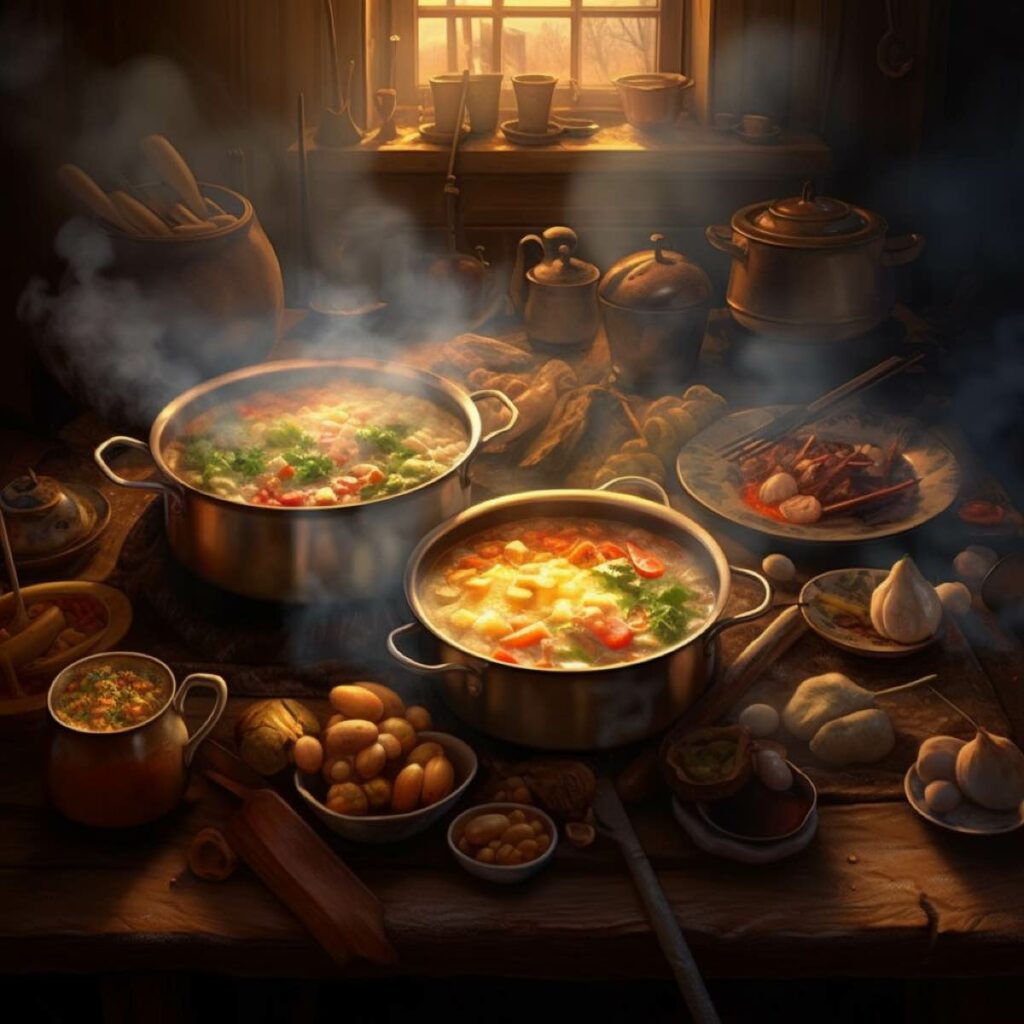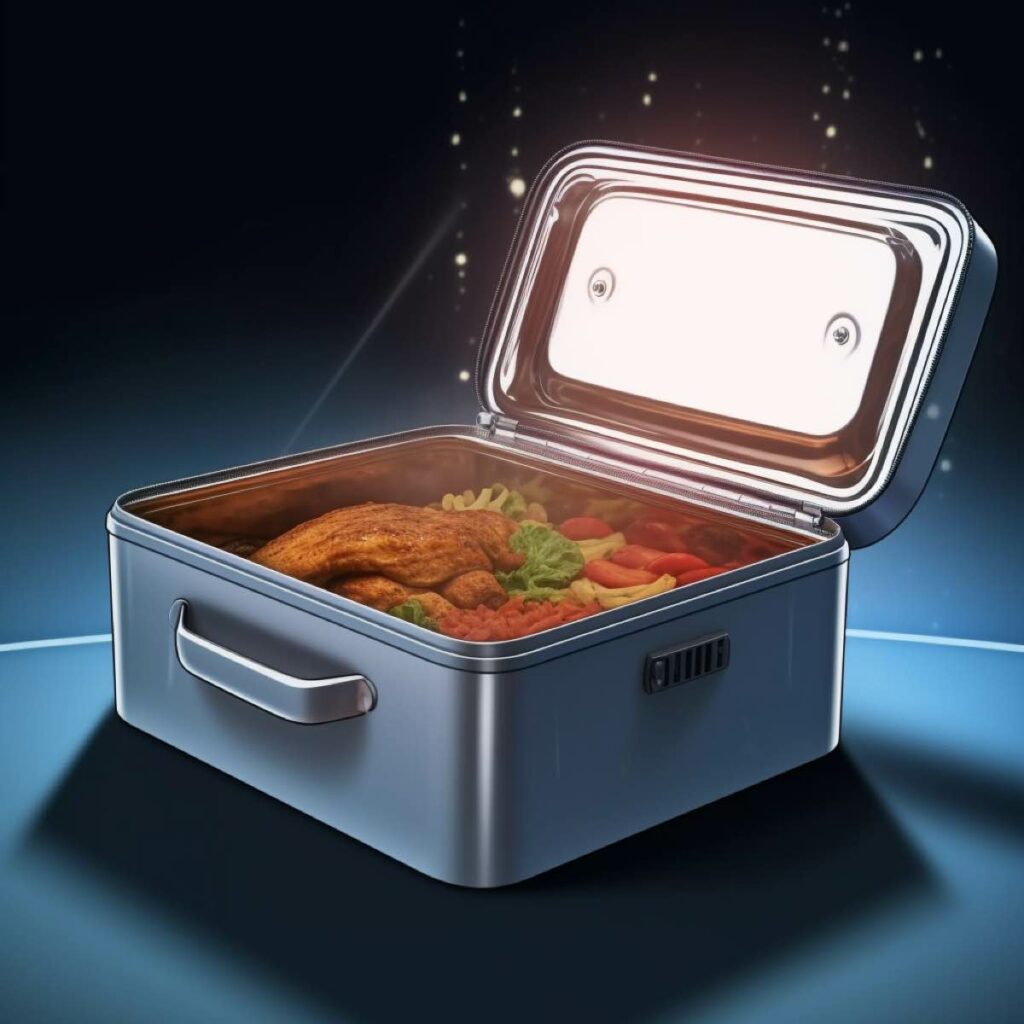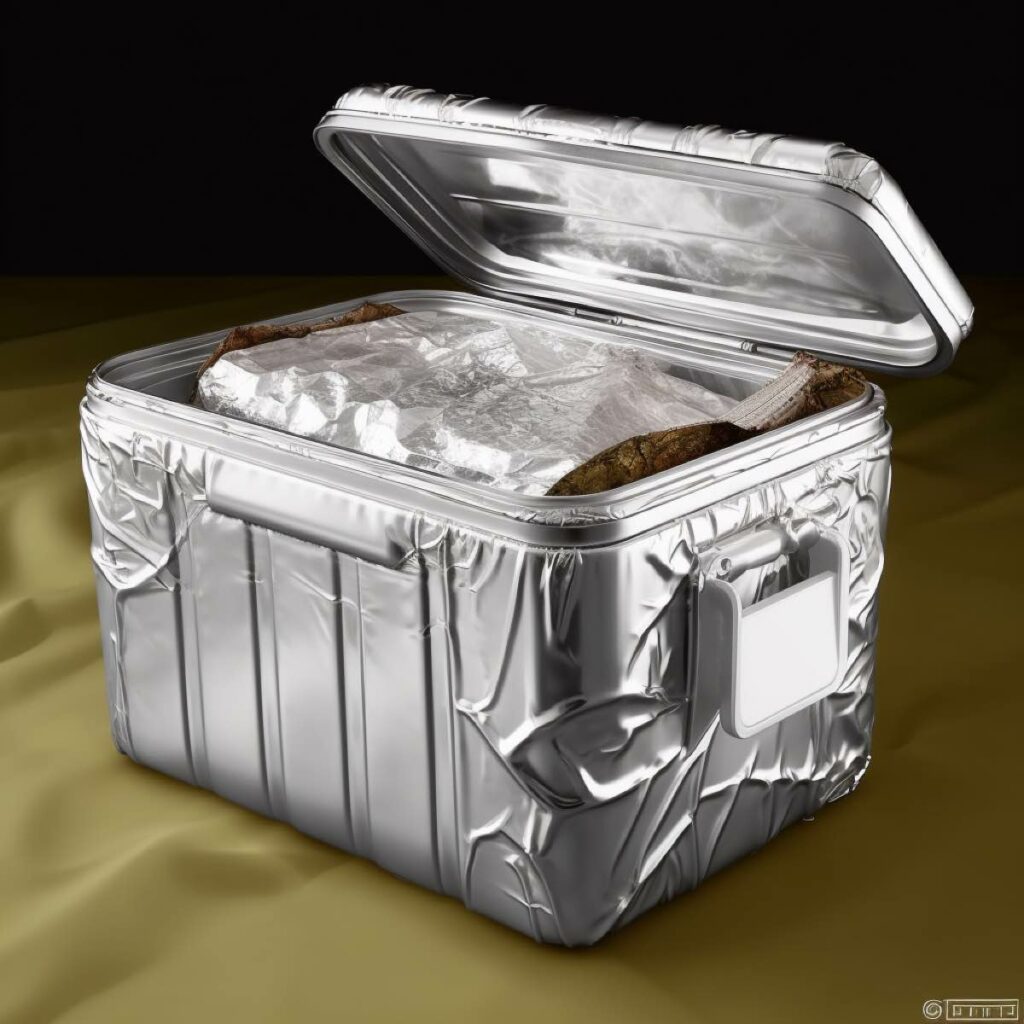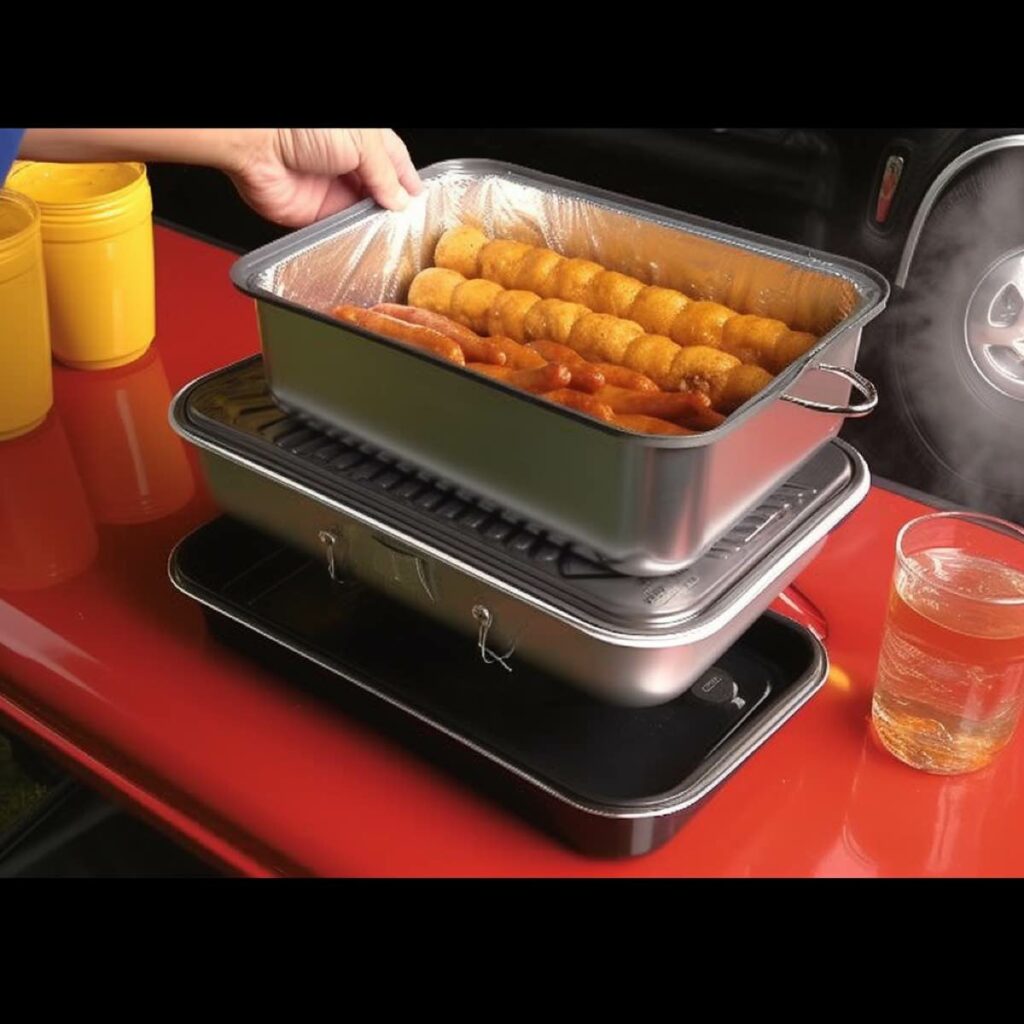How to Keep Food Hot Without Electricity For A Crowd: Tips and Tricks
Keeping food warm without electricity can be a challenge, especially when you have a crowd of people at a picnic, tailgate party, camping or even during a power outage.
However, there are several effective methods that can be used to keep food warm for extended periods of time.
See how to transport warm food in a car.
As someone who loves to cook and enjoys spending time outdoors, I have experimented with various techniques and found some that work better than others.
Insulated Food Carriers : How To Chose The Right One
One of the most important things to consider when keeping food warm is food safety. It’s crucial to ensure that the food stays at a safe temperature to prevent the growth of harmful bacteria.
This is especially important for perishable foods like meat, dairy, and eggs. By following some simple guidelines, it’s possible to keep food warm and safe to eat without electricity.
In this article, I will share some of my favorite methods for keeping food warm in a variety of situations.
19 Ways To Keep Food Warm Without Electricity
- Insulated coolers or bags: Retain heat by placing warm dishes in a preheated cooler or insulated bag.
- Towel or blanket wraps: Wrap hot dishes in towels or blankets to trap heat and maintain temperature.
- Thermal containers or food jars: Use vacuum-insulated containers to keep food warm for extended periods.
- Haybox cooking: Utilize an insulated box filled with hay, straw, or other insulating materials to slow cook and maintain food warmth.
- Chafing dishes with fuel: Use chafing dishes with gel, wick, or solid fuel canisters to provide a steady heat source for keeping food warm.
- DIY warming stations with candles: Create a warming station using bricks and candles to form a stable, heated surface for dishes.
- Terra cotta pot heaters: Use inverted terra cotta pots with candles underneath to create a radiant heat source for food.
- Steam pan setups: Place a steam pan filled with hot water below a serving dish to keep food warm through steam heat.
- Solar cookers: Harness the sun’s energy with solar cookers, such as box, panel, or parabolic designs, to cook and maintain food temperature.
- Cast iron cookware: Preheat cast iron pots or pans and use them to keep food warm due to their excellent heat retention properties.
- Hot water bath: Place serving dishes in a larger container filled with hot water to maintain food temperature through gentle heat transfer.
- Hot bricks or stones: Preheat bricks or stones in a fire, oven, or grill, then place them around or under the serving dish to provide a steady heat source.
- Dutch oven: Use a preheated cast iron Dutch oven to keep food warm by utilizing its heat retention capabilities.
- Grill or camp stove: Keep food warm by placing it on the cooler side of a grill or on a low heat setting of a camp stove.
- Heated serving platters: Preheat oven-safe platters and place food on them to maintain warmth.
- Double boiler: Utilize a double boiler setup with hot water in the bottom pan to warm delicate dishes without direct heat.
- Warming trays with fuel: Use warming trays with fuel canisters (similar to chafing dishes) to maintain the temperature of multiple dishes simultaneously.
- Charcoal or wood-fired ovens: Employ charcoal or wood-fired ovens as an off-grid heat source for maintaining food warmth.
- Reflective heat sources: Create a reflective heat barrier using aluminum foil (tin foil) to direct heat toward the food and maintain its temperature.
Insulated Containers
When it comes to keeping food warm without electricity, insulated containers are a great option.

These containers are designed to keep food warm for several hours, making them perfect for picnics, camping trips, or even for keeping food warm during power outages. Here are a few types of insulated containers you may want to consider:
Insulated Thermal Bags
Insulated thermal bags are a great option for keeping food warm on the go. These bags are made with thick insulation and are designed to keep food warm for several hours. They come in various sizes and shapes, so you can choose one that fits your needs. Some even come with multiple compartments, so you can keep different types of food separate.
Insulated Cooler
An insulated cooler is another option for keeping food warm without electricity. These coolers are designed to keep food cold, but they can also be used to keep food warm. Simply place hot food in the cooler and close the lid tightly. The insulation will help to keep the food warm for several hours.
Insulated Thermos
An insulated thermos is a great option for keeping liquids warm, such as soup or coffee. These thermoses are made with double walls and a vacuum seal, which helps to keep the liquid warm for several hours. They come in various sizes and styles, so you can choose one that fits your needs. Some even come with a built-in cup, making them perfect for on-the-go use.
Overall, insulated containers are a great option for keeping food warm without electricity. Whether you choose an insulated thermal bag, an insulated cooler, or an insulated thermos, you can be sure your food will stay warm for several hours. Just be sure to choose a container that is made with high-quality insulation, such as stainless steel or other materials, to ensure that your food stays warm for as long as possible.
Alternative Heat Sources
When it comes to keeping food warm without electricity, there are several alternative heat sources that you can use. In this section, I will discuss three of the most effective ones: Charcoal Grill, Solar Cooker, and Direct Sunlight.
Charcoal Grill
How to keep food hot for hours – with no electricity – A charcoal grill is a great alternative heat source for keeping food warm. To use it, just light the charcoal and let it burn until it reaches the desired temperature. Then, place the hot coals in a metal container or a heat-resistant tray and cover it with a lid. You can then place your food in the container or tray to keep it warm. ( I would also cover the food to keep it from drying out)
Other helpful tools to keep food warm include heat packs, Cambro food carriers, hot dishes, and keeping food covered to retain heat. With these alternative heat sources and tools, you can keep your food warm and ready to eat, even without electricity.
Water Bath
When it comes to keeping food warm without electricity, one of the most effective methods is the water bath. This method involves placing your food in a container and submerging it in hot water to keep it warm. Here’s how to do it:
Hot Water Bath
To create a hot water bath, you’ll need a large pot or container that is big enough to hold your food container. Fill the pot with water and place it on the stove to heat up. Once the water is hot, place your food container in the pot, making sure it is fully submerged in the water. You can use a lid to cover the food container to help retain the heat.
It’s important to note that you should avoid using boiling water, as this can be dangerous and may cause your food container to crack. Instead, aim for water around 160-180°F, which is hot enough to keep your food warm but not so hot that it will over cook it.
One of the benefits of using a hot water bath is that it’s a safe method for keeping your food warm, as there is no direct heat source touching your food. This method is often used in professional kitchens to keep food warm before it is served.
Overall, the water bath method is an effective way to keep your food warm without electricity. It’s a safe and reliable method that can be used for various dishes, from soups and stews to casseroles and desserts.
Chafing Dishes
When it comes to keeping food warm without electricity, chafing dishes are a great option. These insulated containers are designed to keep food warm for extended periods of time. There are a few things to remember when using chafing dishes, including the type of fuel you use and the cooking method.
Chafing Fuels
Chafing dishes typically use a type of fuel to keep the food warm. There are a few different types of chafing fuels available, including gel, liquid, and solid fuels. Gel fuels are the most popular option, as they are easy to use and provide a consistent heat source. Liquid fuels are also a good choice, but they can be a bit messier to work with. Solid fuels are less common, but they can be useful in certain situations.
Bain-Marie
One common method for using chafing dishes is the bain-marie method. This involves placing a food container inside a larger container filled with hot water. The water provides a consistent heat source that keeps the food warm. This method is particularly useful for dishes that can dry out quickly, such as sauces and gravies.
Double Boiler
Another method for using chafing dishes is the double boiler method. This involves placing a smaller pot or container inside a larger pot filled with hot water. The smaller pot holds the food, while the larger pot provides the heat source. This method is particularly useful for dishes that require gentle, indirect heat, such as custards and delicate sauces.
Chafing dishes are a great option for keeping food warm without electricity. They are easy to use, versatile, and provide a consistent heat source. Whether hosting a party or just trying to keep dinner warm for a few hours, a chafing dish is a great investment.
Solar Cookers
Of course, you need a sunny day – but you will be surprised how the concentration of the sun’s rays (even on a cold day can keep food warm for a party.
Remember, we all used a magnifying glass to start a fire when we were young – so it used a similar principle to warm food.
Direct Sunlight
Direct sunlight is another effective alternative heat source for keeping food warm. Simply place your food in a heat-resistant container and place it in a spot where it will receive direct sunlight. The sun’s rays will then heat up the container and keep your food warm. The suns rays really are only a last resort option and it is better to use a solar cooker.
When using these alternative heat sources, it’s important to keep in mind that they may not be as effective as electricity-powered heating sources. However, they are still a great option for keeping your food warm in a pinch.

Types of Solar Cookers
Box Cookers
Box cookers are the most common type of solar cooker. They are made of an insulated box with a clear lid, which allows sunlight to enter and heat up the food inside. Box cookers are great for slow cooking and can reach temperatures up to 350°F. They are also easy to make at home with basic materials.
Panel Cookers
Panel cookers are made of reflective panels that concentrate sunlight onto a pot or pan. They are lightweight and portable, making them great for camping or outdoor activities. Panel cookers can reach temperatures up to 300°F and are ideal for cooking smaller meals.
Parabolic Cookers
Parabolic cookers are the most powerful type of solar cooker. They use a curved reflector to concentrate sunlight onto a pot or pan, which can reach high temperatures. Parabolic cookers are great for cooking larger meals and can be used in various settings.
Solar cookers are an excellent way to keep food at a warm temperature without electricity. They are easy to use and require no fuel or electricity. With some practice, you can cook various meals using a solar cooker.
Thermal Cooker
Thermal cookers are amazing inventions that have revolutionized cooking without electricity. They use vacuum insulation to retain the heat from the food, keeping it hot for hours on end. Thermal cookers come in various sizes and shapes, with some having cast-iron bottoms that can keep even more heat stored inside. After bringing the food up to a boiling point, they can stay above 160ºF (77ºC) for up to 8 hours and remain over 140ºF (60ºC) – the “danger zone” bacteria growth – for 15 hours or more.
The modern thermal cooker is incredibly versatile and can be used for slow-cooking meals, or just keeping warm food ready to eat, without needing any additional power sources or energy. This makes them fantastic devices if you’re looking to expand your energy-efficient kitchen while still being able to make delicious hearty meals. It means dinner time doesn’t have to coincide with an available power outlet!
Conceptually they are similar to a slow cooker but often have less heat loss and the thermal energy retained longer, which is great for a hot meal.
Gas Stove
Using a gas stove to keep food warm can be beneficial if you need to do it for a short period of time. By adjusting it to the “warming” or “low” setting, you can ensure that the temperature of the food is regulated. However, this method can be unsafe because you may forget to turn off the stove, or the heat intensifies and overcooks or burns your food.
A better way to keep food warm for longer is by using an insulated container or thermal cooker as these methods require no direct heat source and are much more efficient and safer than leaving food on a gas stove. It’s important to note that these warming containers are designed specifically to keep your food at an optimal temperature without burning it, which makes them great options when electricity is not available.
It is always good to have some spare fuel containers, also.

Other Methods
How to keep food warm with aluminum foil
When I need to keep my food warm without electricity, I often turn to aluminum foil. This versatile material can be used in a number of ways to help retain heat. One method is to wrap the food in several layers of foil, creating a tight seal. Another option is to create a makeshift tray out of foil and place the food on top. This tray can then be wrapped in additional layers of foil to keep the heat in.
Towels
Food in Towels can also be used to keep food warm. One option is to wrap the food in a towel and place it in a cooler. The insulation provided by the towel and the cooler will help to retain heat. Another option is to place the food on a towel and wrap it tightly, creating a makeshift insulation layer.
Wood Oven
If you have access to a wood oven, this can be a great way to keep food warm. Preheat the oven to a low temperature (around 200-250 degrees Fahrenheit) and place the food inside. Be sure to cover the food with foil or a lid to help retain heat.

DIY Warming Stations
When it comes to – How to keep food warm for an outdoor party without electricity, there are several DIY warming stations that you can make at home. Here are a few options:
Brick and Candle Setup
One option is to create a warming station using bricks and candles. Here’s how I made mine:
- Gather materials: bricks, candles, and a metal tray.
- Stack the bricks in a square or rectangular shape, leaving space in the middle for the metal tray.
- Place the metal tray in the middle of the bricks.
- Light the candles and place them on the metal tray.
- Place your food in a pot or dish on the metal tray.
This setup works well for keeping smaller dishes warm, like appetizers or side dishes.
Terra Cotta Pot Heaters
Another option is to use terra cotta pots to create a warming station. Here’s how I made mine:
- Gather materials: two terra cotta pots (one larger than the other), candles, and a metal tray.
- Place the larger terra cotta pot upside down on the metal tray.
- Place the candles on top of the upside-down pot.
- Place the smaller terra cotta pot right side up on top of the candles.
- Place your food in a pot or dish on top of the smaller terra cotta pot.
This setup works well for keeping larger dishes warm, like casseroles or roasts.
Steam Pan Setups
Finally, you can use steam pans to create a warming station. Here’s how I made mine:
- Gather materials: a steam pan, water, and sterno fuel.
- Fill the steam pan with water.
- Place the sterno fuel in the designated spot in the steam pan.
- Light the sterno fuel.
- Place your food in a pot or dish on top of the steam pan.
This setup works well for keeping multiple dishes warm simultaneously, like a buffet-style meal.
Overall, these DIY warming stations are easy to make and can be a great solution for keeping your food warm without electricity.
Hot Water Bottle
Hot water bottles are an excellent way to keep food warm and enjoyable. Whether you’re an aspiring chef or want your family or housemates to have a pleasant dining experience, using hot water bottles can help ensure that everyone gets the best version of their meal. Not only does this method ensure that whatever you have prepared stays at its best temperature for a longer time, but it is also easy on your pocket, not requiring any high-cost equipment or resources.
You can use a plastic bottle if you have one, but filling it with warm water won’t provide enough heat for larger dishes or items. That is why wrapping up your food in aluminum foil and towels before placing it in a thermal container bag is recommended. If a cooler is available, it will help preserve the heat while protecting the food from contamination and odors as well. Furthermore, adding a hot water bottle when storing food will last even longer due to the slow release of heat inside the package over time. This budget-friendly method of keeping food deliciously warm has certainly made dinnertime more enjoyable!
Ensuring food safety: Monitoring and maintaining temperatures
As I discussed earlier, keeping food warm without electricity requires planning and preparation. However, it is crucial to ensure that the food remains at a safe temperature to prevent any foodborne illnesses.
To monitor and maintain the temperature of the food, I use a food thermometer. It is essential to check the temperature of the food regularly, especially if it has been sitting out for a while. The temperature should be above 140°F to prevent bacterial growth.
I also make sure to keep the food covered to retain its heat. Covering the food with a lid or foil will prevent heat from escaping and keep the food warm for extended periods.
If I am transporting the food, I use an insulated container or cooler to keep it warm. These containers are designed to maintain the temperature of the food and prevent it from cooling down.
In addition to monitoring the temperature of the food, I also pay attention to the time it has been sitting out. If the food has been sitting out for more than two hours, I discard it to avoid any potential health risks.
Overall, ensuring food safety when keeping food warm without electricity requires careful monitoring and maintenance of temperature. By using a food thermometer, covering the food, and using insulated containers, I can keep the food warm and safe to eat.
Time Management Tips: Planning and Organizing Food Preparation and Warming
When it comes to keeping food warm without electricity, time management is key. Here are some tips that I follow to plan and organize my food preparation and warming process:
- Make a list of dishes and warming methods needed: Before starting, list all the dishes you plan to serve and the warming methods required for each dish. This will help you plan your time and resources accordingly.
- Prep food in advance: To save time on the day of the event, try to prep food in advance. Chop vegetables, marinate meats, and prepare sauces the day before. This will save you time on the event day and allow you to focus on warming the food.
- Use insulated containers: Insulated containers are a great way to keep food warm without electricity. They come in various sizes and can keep food warm for hours. Use them to store soups, stews, and other hot dishes.
- Create a warming station: Set up a warming station with chafing dishes, warming trays, and other equipment. This will make it easier to keep food warm and serve it to your guests.
- Assign tasks to helpers: If you have helpers, assign them tasks such as monitoring the temperature of the food, replenishing the warming dishes, and serving the food to guests. This will help you focus on other tasks and ensure the food stays warm.
By following these time management tips, you can plan and organize your food preparation and warming process efficiently and effectively.